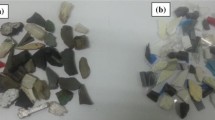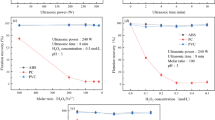Abstract
One method of weakening the inherently hydrophobic surface of plastics relevant to flotation separation is heterogeneous nano-Fe/Ca/CaO catalytic ozonation. Nano-Fe/Ca/CaO-catalyzed ozonation for 15 min efficiently decreases the surface hydrophobicity of brominated and chlorinated flame retardant (B/CFR)-containing plastics (such as acrylonitrile-butadienestyrene (ABS), high-impact polystyrene (HIPS), and polyvinyl chloride (PVC)) in automobile shredder residue (ASR) to such an extent that their flotation ability is entirely depressed. Such a hydrophilization treatment also stimulates the ABS, HIPS, and PVC surface roughness, wetting of the surface, and the thermodynamic equilibrium conditions at the surface and ultimately changes surface polarity. SEM-EDS, AFM, and XPS analyses of the PVC and ABS surfaces demonstrated a marked decrease in [Cl/Br] and a significant increase in the number of hydrophilic groups, such as C–O, C=O, and (C=O)–O. Under froth flotation conditions at 50 rpm, about 99.5 % of ABS and 99.5 % of HIPS in ASR samples settled out, resulting in a purity of 98 and 98.5 % for ABS and HIPS in ASR samples, respectively. Furthermore, at 150 rpm, we also obtained 100 % PVC separation in the settled fraction, with 98 % purity in ASR. Total recovery of non-B/CFR-containing plastics reached nearly 100 % in the floating fraction. The amount of nano-Fe/Ca/CaO reagent employed during ozonation is very small, and additional removal of surface contaminants from the recycled ASR plastic surfaces by ozonation makes the developed process simpler, greener, and more effective.









Similar content being viewed by others
References
Achilias DS, Roupakias C, Megalokonomos P, Lappas AA, Antonakou EV (2007) Chemical recycling of plastic wastes made from polyethylene (LDPE and HDPE) and polypropylene (PP). J Hazard Mater 149:536–542
Ahmad SR (2004) A new technology for automatic identification and sorting of plastics for recycling. Environ Technol 25:1143–1149
ASTM D792-13, Standard Test Methods for Density and Specific Gravity (Relative Density) of Plastics by Displacement, ASTM International, West Conshohocken, PA, 2013. doi: 10.1520/D0792
Bhaskar T, Murai K, Matsui T, Brebu MA, Uddin MA, Muto A, Sakata Y, Murata K (2003) Studies on thermal degradation of acrylonitrile–butadiene–styrene copolymer (ABS-Br) containing brominated flame retardant. J Anal Appl Pyrol 70:369–381
Binks BP, Kirkland M, Rodrigues JA (2008) Origin of stabilisation of aqueous foams in nanoparticle–surfactant mixtures. Soft Matter 4:2373–2382
Burat F, Guney A, Kangal MO (2009) Selective separation of virgin and post-consumer polymers (PET and PVC) by flotation method. Waste Manag 29:1807–1813
Chen SJ, Tian M, Zheng J, Zhu ZC, Luo Y, Luo XJ, Mai BX (2014) Elevated levels of polychlorinated biphenyls in plants, air, and soils at an E-waste site in southern China and enantioselective biotransformation of chiral PCBs in plants. Environ. Sci. Technol. 48:3847–3855
Chung YM, Jung MJ, Lee MW, Han JG (2003) Surface modification effects on film growth with atmospheric Ar/Ar + O2 plasma. Surf Coat Tech 1038:174–175
Cota L, Avalos-Borja M, Adem E, Burillo G (1994) Comparison of irradiation effects of electrons and gamma rays on PVC samples. Radiat Phys Chem 44:579–582
Cui J, Forssberg E (2003) Mechanical recycling of waste electric and electronic equipment: a review. J Hazard Mater 99:243–263
Dimitrakakis E, Janz A, Bilitewski B, Gidarakos E (2009) Small WEEE: determining recyclables and hazardous substances in plastics. J Hazard Mater 161:913–919
Dyakova AK, Trifonov SA, Sosnov EA, Malygin AA (2009) Effect of chemical modification on structural and energy characteristics of the surface of polyethylene and polyvinyl chloride films. Russ J Appl Chem 82:622–629
Fraunholcz N (2004) Separation of waste plastics by froth flotation-a review, part I. Miner Eng 17:261–268
Gilpin R, Wagel D, Solch J (2003) Production, distribution, and fate of polycholorinated dibenzo-p-dioxins, dibenzofurans, and related organohalogens in the environment. In: Schecter A, Gasiewicz T (eds) Dioxins and health, 2nd edn. John Wiley & Sons Inc, Hoboken, NJ
Huiting ES, Pugh RJ (2002) Selective flotation separation of polymers by chemical conditioning with methyl cellulose. Resour Conserv Recycl 235:229–241
Inculet II, Castle GSP, Brown JD (1998) Electrostatic separation of plastics for recycling. Particul Sci Technol 16:91–100
Intyre NSM, Walzak MJ 1995 New UV/ozone treatment improves adhesiveness of polymer surfaces. Mod Plast 79–84, http://infohouse.p2ric.org/ref/29/28881.pdf
Jung CH, Hwang IT, Kwon HJ, Nho YC, Choi JH (2010) Patterning of cells on a PVC film surface functionalized by ion irradiation. Polym Adv Technol 21:135–138
Kano J, Zhang Q, Saito F, Baron M, Nzihou A (2006) Synthesis of hydroxyapatite with the mechanochemical treatment products of PVC and CaO. Process Safety Environ Prot 84:309–312
Krummenacher B Peuch P Fisher M Biddle M (1998) Automatic identification and sorting of plastics from different waste streans-a Status report, APME
Kurose K, Okuda T, Nakai S, Tsai TY, Nishijima W, Okada M (2008) Hydrophilization of polyvinyl chloride surface by ozonation. Surf Rev Lett 15:711–715
Kusic H, Koprivanac N, Loncaric Bozic A (2006) Minimization of organic pollutant content in aqueous solution by means of AOPs: UV- and ozone-based technologies. Chem Eng 123(3):127–137
Lu Y, Miller JD (2002) Carboxyl stretching vibrations of spontaneously adsorbed and LB-transferred calcium carboxylates as determined by FTIR internal reflection spectroscopy. J Colloid Interface Sci 256(1):41–52
Mallampati SR, Heo JH, Park MH (2016) Hybrid selective surface hydrophilization and froth flotationseparation of hazardous chlorinated plastics from E-waste with novelnanoscale metallic calcium composite. J Hazard Mater 306:13–23
Mallampati SR, Kurose K, Okuda T, Nishijima W, Okada M (2008) Selective recovery of PVC-free polymers from ASR polymers by ozonation and froth flotation. Resources, Conservation and Recyclin 52:941–946
Mallampati SR, Okuda T, Kurose K, Tsai TY, Nakai S, Nishijima W, Okada M (2010) Surface ozonation of polyvinyl chloride for its separation from waste plastic mixture by froth floatation. J. Mater. Cycles Waste Manage. 12:326–331
Manfredini M, Marchetti A, Atzei D, Eisener B, Malagoli M, Galavotti F, Rossi A (2003) Radiation-induced migration of additives in PVC-based biomedical disposable devices, part 1. Surface morphology by AFM and SEM/XEDS. Surf Interface Anal 35:395–402
Marques GA, Tenorio JAS (2000) Use of froth fotation to separate PVC/PET mixtures. Waste Manag 20:265–269
Miller JD, Drelich J, Payne T, Kim JH, Kobler RW, Christiansen S (1998) Selective froth flotation PVC from PVC/PET mixtures for the polymers recycling industry. Polym Eng Sci 38:1378–1386
Mitoma Y, Mallampati SR, Miyata H, Kakeda M (2013) Decomposition of polychlorinated biphenyls in soil with a dispersion mixture of metallic calcium and calcium oxide. Arch Environ Contam Toxicol 64:180–186
Mitoma Y, Simion AM, Mallampati SR, Miyata H, Kakeda M, Simion C (2016) Hydrodechlorination of PCDD/PCDF/PCB contaminants by simple grinding of contaminated soils with a Nano-size calcium reagent. Environ Prog Sustain 35:34–40
Okuda T, Kurose K, Nishijima W, Okada M (2007) Separation of polyvinyl chloride from plastic mixture by froth flotation after surface modification with ozone. Ozone Sci Eng 29:373–377
Pappa G, Boukouvalas C, Giannaris C, Ntaras N, Zografos V, Magoulas K, Lygeros A, Tassios D (2001) The selective dissolution/precipitation technique for polymer recycling: a pilot unit application. Resour Conserv Recycl 34:33–44
Park CH, Jeon HS, Kim WT, Park JK (2005) The material separation of covering plastics in the waste electric wires by electrostatic separation. J Korean Soc Waste Manage 22:138–144
Park CH, Jeon HS, Yu HS, Han OH, Park JK (2008) Application of electrostatic separation to the recycling of plastic wastes: separation of PVC, PET, and ABS. Environ. Sci. Technol. 42:249–255
Pascoe RD, Connell BO (2003) Flame treatment for the selective wetting and separation of PVC and PET. Waste Manag 23:845–850
Pérez-Belis V, Bovea MD, Ibáñez-Forés V (2015) An in-depth literature review of the waste electrical and electronic equipment context: trends and evolution. Waste Manag Res 33:3–29
Pi H, Xiong Y, Guo S (2005) The kinetic studies of elimination of HCl during thermal decomposition of PVC in the presence of transition metal oxides. Polym Plast Technol Eng 44:275–288
Pongstabodee S, Kunachitpimol N, Damronglerd S (2008) Combination of threestage sink-float method and selective flotation technique for separation of mixed post-consumer plastic waste. Waste Manag 28:475–483
Rabek JF, Ranby B, Ostensson B, Flodin P (1979) Oxidation of polyene structures in poly(vinyl chloride) by molecular oxygen and singlet oxygen. J Appl Polym Sci 24:2407–2413
Reddy MS, Kurose K, Okuda T, Nishijima W, Okada M (2007) Separation of polyvinyl chloride (PVC) from automobile shredder residue (ASR) by froth flotation with ozonation. J Hazard Mater 147:1051–1055
Saeki S, Kano J, Saito F, Shimme K, Masuda S, Inoue T (2001) Effect of additives on dechlorination of PVC by mechanochemical treatment. J Mater Cycles Waste Manage 3:20–23
Sancheza MDR, Blasa MMP, Martıneza JMM, Walzak MJ (2005) Addition of ozone in the UV radiation treatment of a synthetic styrene-butadiene-styrene (SBS) rubber. Int Adhes Adhes 25:358–370
Sanders EM, Zeronian SH (1982) Ananalysis of the moisture-related properties of hydrolyzed polyester. J Appl Polym Sci 27:4477–4491
Schlummer M, Gruber L, Maurer A, Wolz G, Eldik RV (2007) Characterisation of polymer fractions from waste electrical and electronic equipment (WEEE) and implications for waste management. Chemosphere 67:1866–1876
Schmitt BR, Kim H, Urban MW (1999) Microwave plasma reactions of imidazole on poly(vinyl chloride) surfaces: a spectroscopic study. J Appl Polym Sci 71:1–6
Simoneit BT, Medeiros P, Didyk B (2003) Combustion products of plastics as indicators for refuse burning in the atmosphere. Environ. Sci. Technol. 37:652–656
Sinha D, Swu T, Tripathy SP, Mishra R, Dwivedi KK, Fink D (2003) Gamma-photon induced modification of polyvinyl chloride (PVC) film. Radiat Eff Defects Solid 158:593–598
Sommer EJ, Rich JT (2001) Application of raman spectroscopy to identification and sorting of post-consumer plastics for recycling, U.S. Patent 6313423
Summerlin LR, Borgford LC, Ealy BJ (1988) Producing hydrogen gas from calcium metal: chemical demonstrations: a sourcebook for teachers, Washington, D.C. American Chem Soci 2:51–52
Tian M, Chen SJ, Wang J, Zheng XB, Luo XJ, Mai BX (2011) Brominated flame retardants in the atmosphere of e-waste and rural sites in southern China: seasonal variation, temperature dependence, and gas-particle partitioning. Environ Sci Technol 45:8819–8825
Vig JR (1984) UV/ozone cleaning of surfaces. J Vac Sci Technol A3:1027–1034
Wey MY, Yu LJ, Jou SI (1998) The influence of heavy metals on the formation of organics and HCl during incinerating of PVC containing waste. J Hazard Mater 60:259–270
Y. Yuan, T. Randall Lee, Contact Angle and Wetting Properties, in G. Bracco, B. Holst (eds.), Surface Science Techniques, Springer Series in Surface Sciences 51,_1, Springer-Verlag Berlin Heidelberg 2013 doi:10.1007/978-3-642-34243-1
Zhang W, Chu PK, Ji J, Zhang Y, Liu X, Fu RK, Ha PC, Yana Q (2006) Plasma surface modification of poly vinyl chloride for improvement of antibacterial properties. Biomaterials 27:44–51
Zou Y, Kizhakkedathu JN, Brooks DE (2009) Surface modification of polyvinyl chloride sheets via growth of hydrophilic polymer brushes. Macromolecules 42:3258–3268
Acknowledgments
This study was financially supported by 2017 research funds from the University of Ulsan, Ulsan, Korea.
Author information
Authors and Affiliations
Corresponding authors
Additional information
Responsible editor: Suresh Pillai
Rights and permissions
About this article
Cite this article
Mallampati, S.R., Lee, B.H., Mitoma, Y. et al. Heterogeneous nano-Fe/Ca/CaO catalytic ozonation for selective surface hydrophilization of plastics containing brominated and chlorinated flame retardants (B/CFRs): separation from automobile shredder residue by froth flotation. Environ Sci Pollut Res 24, 4469–4479 (2017). https://doi.org/10.1007/s11356-016-8074-2
Received:
Accepted:
Published:
Issue Date:
DOI: https://doi.org/10.1007/s11356-016-8074-2




